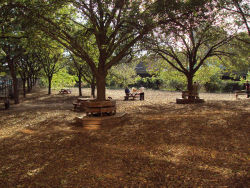Hillside Dog Park
Hillside Dog Park
What was here before?
Once known as Ihpetonga -- Algonquin for the high sandy banks -- this area was inhabited by the Marechkawieck until around 1637 when the land was conveyed to the Dutch settlers who arrived here a few years earlier. From 1645 to 1647, they established six plantations, eventually forming the village of Breuckelen.
The area grew as an agricultural community throughout the eighteenth century, eventually making up 31 percent of the King’s County population. Industrialization of the area began in 1814 when Robert Fulton (1765-1815) and prominent Brooklyn Heights developer Hezekiah B. Pierrepont (1768-1838) converted the ferry at Brookland Ferry Landing to a scheduled, steam-operated service.
In 1868, Saint Vincent’s de Paul Society purchased two buildings on this property, and in 1869, St. Vincent’s Home for Boys opened its doors. Lodgers, boys under sixteen, were expected to pay ten cents a day for their stay, which many made by delivering newspapers. Known as the ‘Newsboy’s Home,’ shelters such as St. Vincent’s were exceedingly common around this time. As the boys depended on the income delivering papers to pay their shelter fees, the newspaper industry became dependent on cheap labor, eventually leading to the largest child-led strike in history and inspired the 1992 musical Newsies.
How did this site become a dog park?
Acquired by NYC Parks in 1946 and 1947 during the proceedings for mapping the Brooklyn-Queens Expressway, then known as the Brooklyn-Queens Connecting Highway. This site was not needed for the highway construction itself, so it became parkland.
Over the years, many proposals for Hillside, including plans to build baseball fields and tennis courts, were thwarted because of the site's namesake unusual topography. Commercial proposals and requests to lease the land as a parking lot have also been rejected because of the community's lack of other recreational spaces. Community members now use the park to run their dogs, garden, relax, and socialize.
Check out your park's Vital Signs
Clean & Safe
Green & Resilient
Empowered & Engaged Users
Share your feedback or learn more about how this park is part of a
Vital Park System

